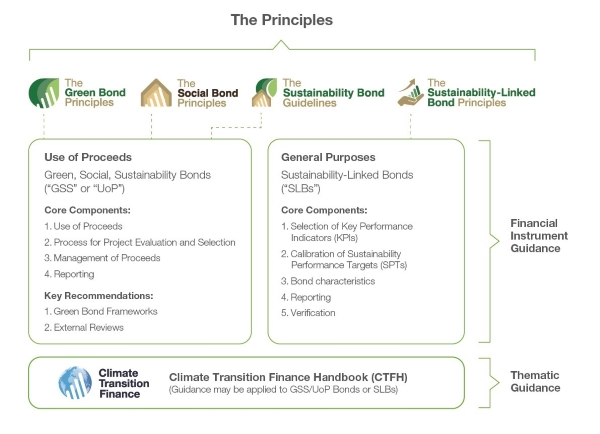
The first update to the Green Bond Principles (GBP) since 2018 was issued on Thursday, including formalising recommendations that bond frameworks and external reviews be used, and a recommendation of heightened transparency around issuer-level sustainability aims.
The recommendations that issuers should have a bond framework and obtain an external review now sit alongside the four pillars of the principles – use of proceeds, process of project evaluation, management of proceeds, and impact reporting. (See illustrative diagram further below.)
Alongside these two recommendations and that regarding issuer-level strategies and targets, the new edition of the GBP encourages transparency around alignment of projects with taxonomies, and around processes to identify and manage environmental and social risks.
The 2021 edition marks the sixth version of the GBP since they were first launched in 2014.
Johanna Köb, vice chair of the executive committee of the Green Bond Principles and Social Bond Principles (SBP) and head of responsible investment at Zurich Insurance (pictured above, centre), said the hiatus in updates over the past three years allowed for a period of stability, during which the market could grow and develop. She noted that since 2018, the market for green, social and sustainability bonds has grown tremendously, with much diversification in terms of types of issuers, uses of proceeds, and geographic reach, while a large set of best practice has also been developed.
“What we wanted to do with this update is really make sure that we solidify and support this notion of where best practice truly stands today and signal that back to the market,” said Köb, who was speaking alongside other GBP and SBP representatives in a virtual event organised by the International Capital Market Association (ICMA), which operates the secretariat for the principles.
Issuers whose green bonds have been hitherto aligned with the principles will remain so, with the update not representing a big change for most, but an explicitly stated confirmation of what they are doing, according to Tanguy Claquin, global head of sustainable banking, Crédit Agricole, and vice chair of the executive committee of the GBP SBP (pictured above, right).
“It was a bit like a missing element of the GBP,” he added.
Within bond frameworks, it is now recommended that issuers provide context of their overarching sustainability strategies, potentially referencing the five high level objectives of the GBP: climate change mitigation; climate change adaptation; natural resource conservation; biodiversity conservation; and pollution prevention and control.
“We’re saying that a thematic bond programme should not be an ad hoc to an issuer’s profile, but that the spirit of sustainability be evident at the issuer’s enterprise level,” said Denise Odaro, chair of the principles and head of investor relations at the International Finance Corporation (IFC) (pictured above, left).
Regarding the encouragement for issuers to discuss alignment around taxonomies, the GBP SBP representatives noted how such regulatory standards are emerging around the world.
“While once this was truly at the fringes of capital markets, it’s now front and centre,” said Köb. “Given that we have such a global constituency, it’s very important for us to note that this is happening, to make reference to it, and give guidance to the members.”
Issuers are also now encouraged to identify known material risks of negative social and/or environmental impacts from eligible projects, reflecting developments such as the “do no significant harm” (DNSH) and social safeguards aspects of the EU Taxonomy.
The SBP and Sustainability Bond Guidelines have in parallel been revised to reflect the above changes and remain consistent with the GBP.
Source: ICMA
Alongside the update to the principles, guidance was provided on a variety of other areas dealt with under the Green, Social, Sustainability and Sustainability-Linked Bond (SLB) Principles. One offers illustrative examples for selection of KPIs for SLBs.
Odaro said that the issue of selecting KPIs that are material is an important matter that comes up often in the IFC’s discussions with potential issuers in emerging markets.
“This publication will be welcomed by issuers that are in the dark as to where to even begin thinking about KPIs,” she said.
Also published were guidelines for impact reporting databases, which provide guidance to providers on several topics including ethical standards, governance and data security, referencing impact calculation and methodology, among others.
“Many investors view the sustainable bond markets through an impact lens, and will certainly welcome this year’s updates,” said Köb.
Following the announcements and against the backdrop of burgeoning issuance, the GBP SBP representatives were optimistic about the future of the sustainable market.
“There is a gargantuan task ahead of us if we are to achieve 2030,” Odaro said. “The role the bond market plays is just phenomenal and cannot be underestimated in terms of channeling the financing needed to achieve all the sustainability goals.
“I do expect that these changes will be welcomed by the market,” she added. “Being mindful, of course, of jurisdictional challenges and evolving regulation, I do predict higher issuance.”




